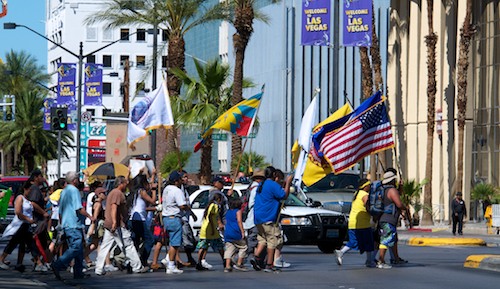I want to share a story with you about an amazing event that took place this past Earth Day. For three days, in 100+ degree heat, Native Americans led a50-mile march to draw attention to the devastating effects of coal pollution on their community
The Sierra Club was proud to support the Moapa Band of Paiutes on their three-day, 50-mile cultural healing walk from their reservation to the Lloyd George Federal Building in Las Vegas in order to bring visibility to the damage that the Reid Gardner coal-fired power plant is doing to the tribe’s health, culture and economy. In the 50-mile march, tribal members and supporters from tribal nations across the Southwest walked from their homeland to the doorstep of federal decision makers.
“We were here, we are here, and we will be here,” Moapa Paiute member Calvin Meyers says of his tribe’s relationship to their historical lands. The Moapa Band of Paiutes tribal lands abut Reid Gardner, Southern Nevada’s last coal-burning power plant, owned by NV Energy. Tribal members and local residents have been suffering for years from numerous pollution problems at the plant.
“It’s not just air pollution from the coal plant and its old boilers,” says Barb Boyle, a Senior Campaign Representative for Sierra Club’s Beyond Coal Campaign. “There are also several settling ponds for coal ash residue, there are enormous piles of coal that are uncovered, and a huge coal ash landfill that is also uncovered.”
The toxic coal dust at Reid Gardner is picked up during Southern Nevada’s frequent wind storms, blows over tribal lands, the town of Moapa, Mesquite and up to pristine areas like the Grand Canyon and Zion National Parks, threatening public health and creating regional haze pollution. The tribe wants the plant retired and replaced with clean energy.
Tribal members suffer from asthma attacks, allergies, sinus problems, ear infections, and thyroid disease that they believe directly result from their constant exposure to particulates that blow from the toxic coal ash disposal ponds onto the tribal lands, covering their cars, their homes and their families.
“People on the Moapa reservation have high rates of lung and heart disease,” says Barb. “This is a tribe that has born this burden for decades. It’s time to stop.”
The Moapa cultural walk ended Sunday with a large rally where 150 people listened to speakers call for the closure of the Reid Gardner coal plant, and heard moving stories of the health problems for the young and old in the Moapa community. Members of the Moapa Pauites, the Las Vegas Paiutes, and the Shivwitts of Utah spoke about the dirty coal plant in their native languages, and performed traditional dances and songs.
Here’s a great TV news clip from the rally.
The next step happens on May 3, when EPA holds a public hearing on the Moapa reservation regarding a pollution permit for Reid Gardner. There’s another hearing on the same day just down the road from the reservation as well. Sign up here to attend the hearings.
“We want to get this plant retired as soon as possible,” Barb says. “That area has an amazing array of renewable energy resources — it’s a perfect place for solar power. The Moapa tribe is already working on a 350-megawatt solar system for their land.”
We can do better than coal — for the Moapa Band of Paiutes, other Native American tribes, and all Americans.



